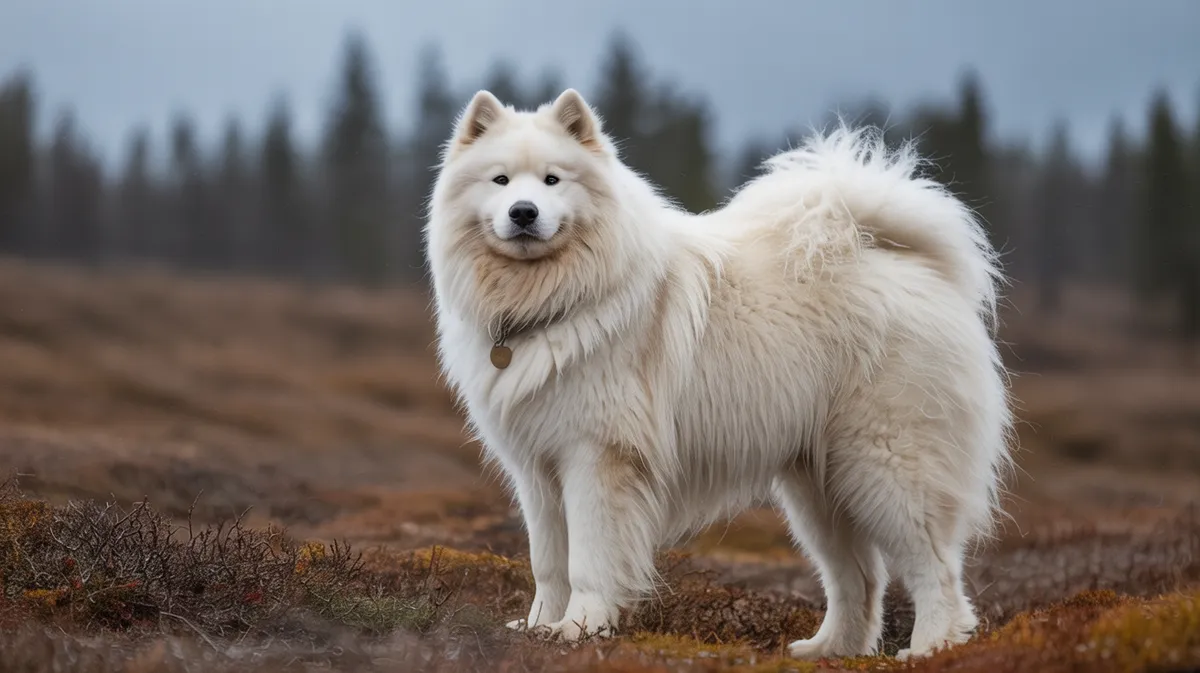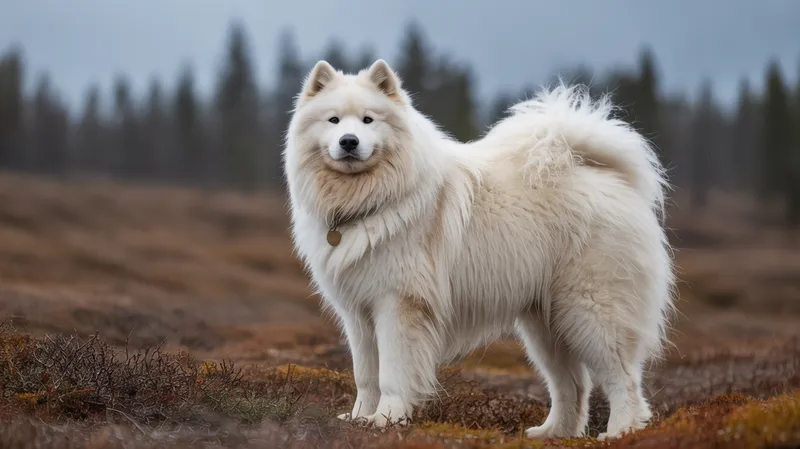
Samoyed
Canis lupus familiaris

Meet the Samoyed
The Samoyed is a large, fluffy breed of domestic dog originally bred by the Samoyedic peoples of Siberia to herd reindeer and pull sleds. Known for its iconic 'Sammy smile,' this breed has a thick, white double coat that helps it thrive in extremely cold climates. Samoyeds are highly social, gentle, and intelligent, making them excellent family companions as well as working dogs. Their strong build and endurance are matched by a playful, affectionate temperament. They are also well-known for being vocal and alert, often communicating with their families through a range of barks and howls.
Classification
Mammal
Habitat
Domestic, originally Arctic tundra
Diet
Omnivore
Lifespan
12–14 years
Conservation
Least Concern
Weight
16–30 kg (35–66 lbs)
📖Fascinating Facts
Arctic Origins
Samoyeds were developed by the Samoyede tribes of Siberia to work in harsh Arctic conditions, herding reindeer and pulling sleds.
The 'Sammy Smile'
Their distinctive smiling expression is not just adorable but also functional, preventing drool from freezing on their faces.
Woolly Coats
Samoyed fur is so thick and soft that it has been spun into yarn and woven into warm garments by indigenous peoples.
📋Detailed Description
The Samoyed is a medium to large-sized working dog breed, typically weighing between 20–30 kg (44–66 lbs) and standing 48–60 cm (19–23.5 in) at the shoulder. Its most distinctive feature is a dense, weather-resistant double coat, with a coarse, straight outer layer and a soft, woolly undercoat, providing exceptional insulation against Arctic temperatures as low as −60°C (−76°F). The breed’s head is wedge-shaped with erect, triangular ears and a characteristic upturned mouth known as the 'Sammy smile,' which helps prevent icicles from forming on the lips. Samoyeds possess a strong, muscular build with a deep chest and a plumed tail that curls over the back, often used to cover the nose while sleeping to conserve heat. Highly intelligent and energetic, Samoyeds are renowned for their stamina and versatility, historically excelling at herding, sled pulling, and guarding. They are highly social, forming close bonds with humans and other dogs, and are known for their gentle, patient disposition, especially with children. Their vocalizations include barks, howls, and a unique 'talking' behavior, reflecting their communicative nature. Samoyeds are also noted for their problem-solving abilities and adaptability, thriving in both working and companion roles. Their lifespan averages 12–14 years, with robust health but some predisposition to genetic conditions such as hip dysplasia and progressive retinal atrophy.
💡 Did you know?
Despite their majestic looks, Samoyeds are notorious for their mischievous and playful behavior, making them both charming and challenging pets.
🔬Research & Sources
Wikipedia Summary
Samoyed may refer to:A member of the Samoyedic peoples, indigenous peoples of Siberia who speak the Samoyedic languages The Samoyedic languages they speak, part of the Uralic family In the past "Samoyeds" referred only to the Nenets people Samoyed dog, a Eurasian dog breed descended from hunting and herding dogs from Siberia
Last Modified: 12/5/2024
🎭Behavior & Social Structure
Samoyeds exhibit complex social behaviors, reflecting their origins as cooperative working dogs. They are highly people-oriented, seeking frequent interaction and displaying separation anxiety if left alone for extended periods. In group settings, Samoyeds establish clear hierarchies but are generally non-aggressive, relying on vocalizations and body language for communication. Their playfulness persists into adulthood, and they often engage in games that mimic herding or pulling. Feeding behavior is omnivorous, though they historically adapted to high-protein, high-fat diets due to the scarcity of plant material in Arctic regions. Samoyeds are alert and vigilant, making them effective watchdogs, though they are not typically aggressive toward strangers. Daily routines require substantial physical and mental stimulation, including long walks, play, and problem-solving activities to prevent boredom-related behaviors such as digging or excessive barking.
👶Reproduction & Life Cycle
Samoyeds reach sexual maturity between 8–12 months, with females typically coming into estrus twice a year. Mating is usually preceded by courtship behaviors such as play-bowing and mutual grooming. The gestation period averages 63 days, after which litters of 4–8 puppies are born. Samoyed mothers are attentive, providing extensive care, warmth, and grooming to the altricial pups. Weaning occurs at 6–8 weeks, with socialization beginning early through interactions with littermates and humans. Responsible breeders emphasize genetic screening to reduce inherited disorders. There is no strict breeding season for domestic Samoyeds, though in their native environment, births often coincided with spring to maximize survival rates.
🛡️Adaptations & Survival
Samoyeds have evolved several adaptations to Arctic life, including their dense double coat, which insulates against extreme cold and repels moisture. Their black lips, eye rims, and nose reduce the risk of frostbite, while their upturned mouth prevents saliva from freezing. The breed’s plumed tail is used as a thermal cover during sleep. Their feet are well-furred and slightly splayed, functioning as natural snowshoes. Behaviorally, Samoyeds are highly cooperative and responsive to human cues, reflecting their long history of close human partnership. Their endurance and metabolic efficiency enable them to perform strenuous work over long distances with minimal food.
📚Research Sources
🎨Cultural Significance
The Samoyed dog holds deep cultural significance among the Samoyedic peoples of Siberia, particularly the Nenets, who relied on these dogs for herding reindeer, pulling sleds, and providing warmth. Samoyeds often slept with their human families inside tents, acting as living blankets. In Western culture, Samoyeds became renowned during polar expeditions of the late 19th and early 20th centuries, notably serving on Fridtjof Nansen’s and Robert Falcon Scott’s Arctic and Antarctic journeys. The breed symbolizes endurance, loyalty, and companionship, and is celebrated for its gentle nature and iconic smile. Samoyeds have also influenced modern sled dog breeds and remain popular as show dogs and family pets.
🔬Recent Research & Discoveries
Recent genetic studies have confirmed the ancient lineage of the Samoyed, showing close genetic ties to other Arctic breeds such as the Siberian Husky and Alaskan Malamute, as well as to indigenous Siberian wolf populations. Studies on coat genetics have identified specific alleles responsible for the Samoyed’s unique white coloration and dense fur. Ongoing research focuses on breed-specific health issues, particularly autoimmune diseases and hereditary eye conditions, with international breed clubs supporting biobanking and genetic diversity initiatives. Behavioral research highlights the Samoyed’s advanced social cognition and adaptability, making them valuable models for studying canine-human cooperation.
🎥Wildlife Videos

Fussy Samoyed Puppy Makes An Unlikely New Best Friend | Too Cute!
Seymour the fussy little Samoyed pup just wants to find someone to give him all the attention he deserves. He finds an unlikely ...
Animal Planet

THE SAMOYED DOG - EVERYTHING ABOUT THE BREED / Animal Watch
Anneka meets Kate Muncaster and her beautiful pack of samoyeds, races them on a rig, finds out about temperament, diet, ...
Animal Watch

This 3-legged abandoned Samoyed mix dog's daily park routine will leave you in awe
Meet the amazing 3-legged dog who has captured the hearts of everyone at the park. Despite his disability, he never fails to show ...
Animal Inc.

Wolf, Samoyed and wolf/samoyed puppies. The adventures of the wild wild wolf
Home movies and photos from 'The Adventures of the Wild Wild Wolf'. This video contains beautiful live footage of Kinapak the ...
Tanya Gerard

Why Do Dogs Wag Their Tails? | How Do Animals Do That?
Uncover the science behind a dog's tail wag, and find out exactly why zebras have black and white stripes. Stream Full Episodes ...
Animal Planet
🌍Habitat Information
The Samoyed typically inhabits Domestic, originally Arctic tundra environments. Samoyeds have adapted to their environments with specialized features and behaviors.
Primary Habitat:
Domestic, originally Arctic tundra
More detailed habitat information will be available soon.
🛡️Conservation Status
The Samoyed is currently classified as Least Concern. Conservation efforts are crucial for preserving this species for future generations.
Common Threats:
- 🏠Habitat loss and fragmentation
- 🌡️Climate change impacts
- 🎯Hunting and poaching
- 🏭Human-wildlife conflict
⚠️Threats & Conservation Challenges
As a domestic breed, Samoyeds are not threatened in the wild, but they face challenges related to genetic health, including hip dysplasia, progressive retinal atrophy, and autoimmune disorders. Unscrupulous breeding practices can exacerbate these issues. Modern lifestyles may not always provide the physical and mental stimulation Samoyeds require, leading to behavioral problems. Climate change and urbanization have reduced traditional working roles, increasing the risk of obesity and related health problems in pet populations. Responsible breeding, health screening, and owner education are essential for maintaining breed welfare.
🔬Scientific Classification
Scientific Name
Canis lupus familiaris
Classification Hierarchy
🔍 About Taxonomic Classification
Taxonomic classification is a hierarchical system used by scientists to classify and organize living organisms based on shared characteristics and evolutionary relationships.
The system moves from broad categories (Kingdom) to increasingly specific ones, with each animal's scientific name typically consisting of its Genus and species.
📝Community Notes
Share your observations and insights about the Samoyed with our community of wildlife enthusiasts.
Join Our Community
Sign in to share your observations and connect with fellow wildlife enthusiasts.
Sign In to ContributeNo community notes yet
Be the first to share your observations about the Samoyed!
Explore Samoyed
Select a tab above to learn more about this amazing animal.
📸Photo Gallery
No photos available for this animal yet.
🌟Discover More Wildlife
Continue your journey of discovery with more fascinating animals from our database
